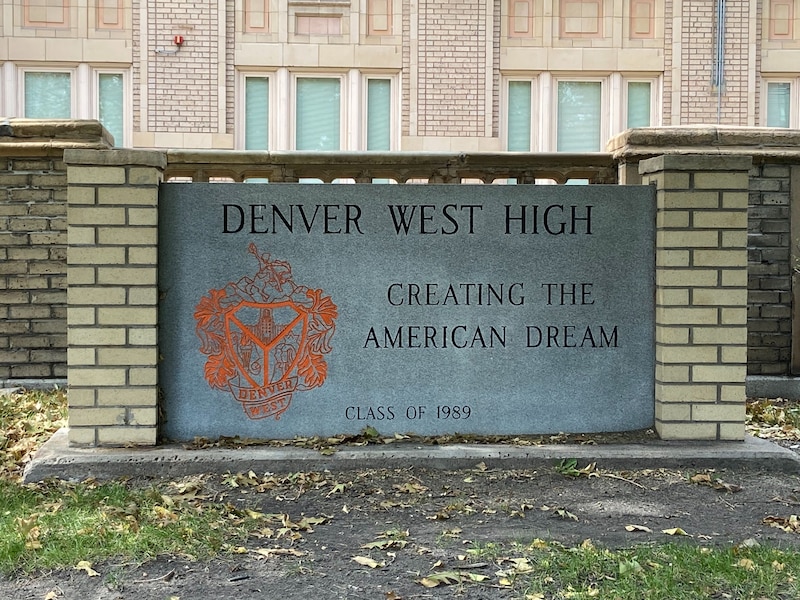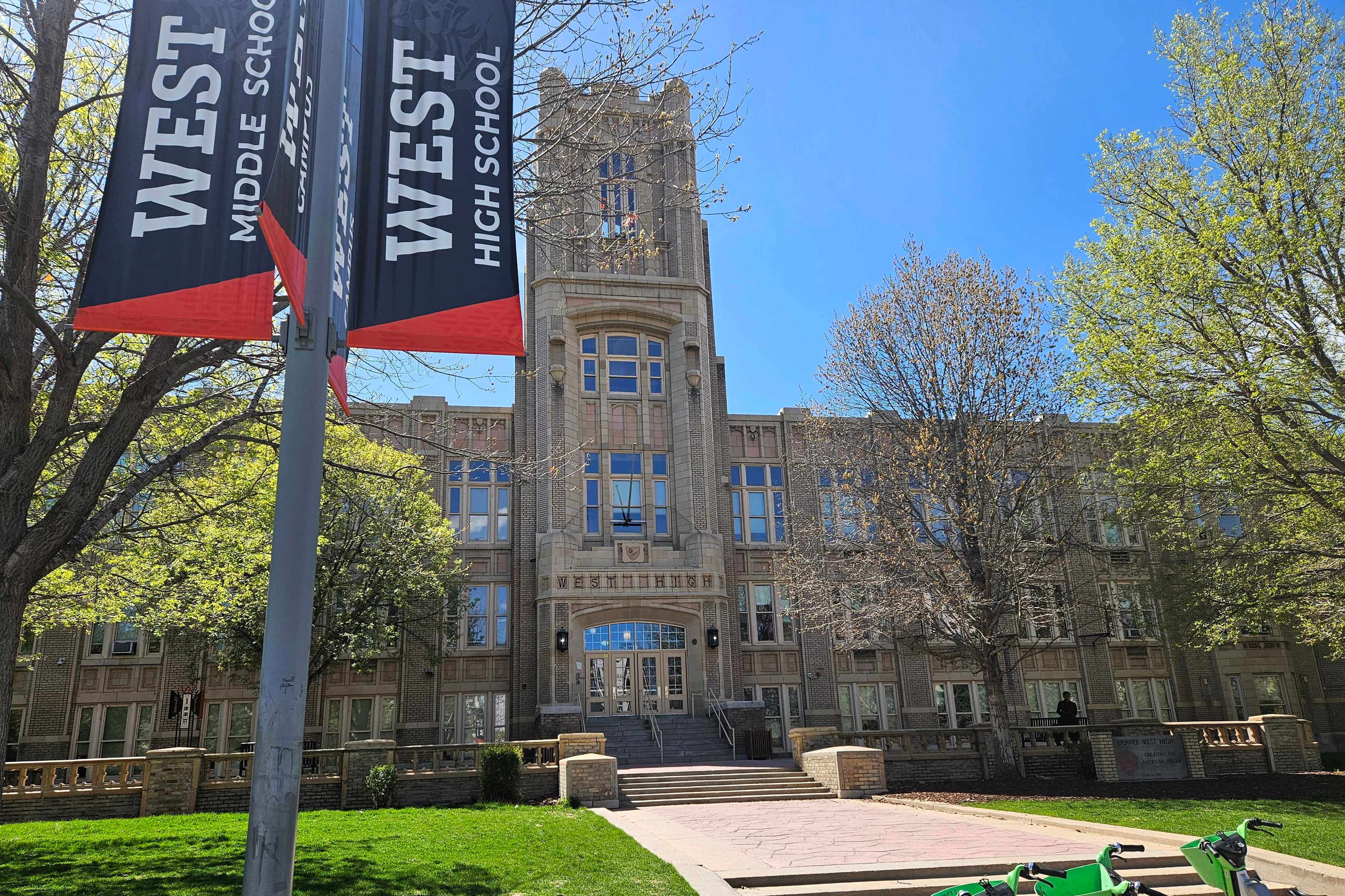After moving from a high school in Jefferson County with about 1,400 students to West High School in Denver with under 600 students, 18-year-old Kyree Romo noticed a lot of differences.
She’s happier at her new school, she said, and being around more teachers and students of color makes her feel seen.
But there are challenges for her and other students at West High, too.
Students at West say their school doesn’t have as many course offerings or clubs as larger schools. For instance, West doesn’t have a robotics class or club. It doesn’t have lots of business classes, language options, or art classes. And next year, West is losing more teachers as its enrollment declines.
To help reverse that trend, the students have a request for Denver Public Schools: Reevaluate the boundaries that determine which students are assigned to West.
“Outdated district boundaries result in less students, less teachers, less classes,” Romo said. “This directly impacts students and equitable access to the opportunities that we deserve.”
However, district officials say a boundary change for West wouldn’t make much difference.
Unlike generations ago, a school’s enrollment isn’t just a matter of which students live in its boundary. For more than a decade, DPS has encouraged, and in some areas mandated, families to choose any school in their neighborhood or the entire district.
Supporters of the school choice system say it allows families to choose schools that best fit their children’s needs. Critics say choice has contributed to school segregation and is not accessible to all families because the district doesn’t always provide transportation for students.
Critics of school choice also believe it has created a cycle where schools that have declining enrollment — whether it’s due to academic issues, gentrification, or demographic changes — have a tougher time attracting students and recovering. Denver schools are funded per student, and fewer students means less money to hire teachers and offer a variety of classes. It’s hard for a school to attract more students when families and students notice that it has few resources.
The West students aren’t giving up. Students say that they know some families in west Denver choose to enroll in other schools, in part because they’re drawn to the wider course variety. But students say the draw of West is the unity of the school and the relationships.
“Here, you have teachers asking you about your life,” Romo said.
Recent recommendations also suggest a look at boundaries
West High is one of Denver’s oldest schools, and has a long history of student activism that goes back to student walkouts protesting racism in the late 1960s. In recent years, students successfully advocated to reunify the school after it was split into two smaller schools in an attempt to boost test scores. The reunified West High opened in 2021.
Even with the consolidation, enrollment is now under 600 students, down from about 800 in the fall of 2018. The vast majority of the students are from low-income families: 94% are eligible for free or reduced-price school meals.
Last month, West High students asked the Denver school board for a new system that regularly evaluates district boundaries to keep up with changing demographics in the city, and as a way to give students at West the opportunity to have more resources. DPS hasn’t done a districtwide reevaluation of school boundaries in decades.
The same recommendation was included in a recent report commissioned by Denver Public Schools called the La Raza Report, and was among many recommendations to improve the education of Latino students in the district. West was one of the few schools called out by name in the 22-page executive summary of the report.
“Consider redrawing boundaries for West High School — develop a benefit/cost analysis strategy,” the report says. It also recommends that the district “assess the impact of transportation options” at West and at Lincoln High School in southwest Denver.
To study the impact declining enrollment has had on their school, the West students compared the course offerings at West with what other Denver high schools offer. For example, East High School, which serves an adjacent zone, has more than 2,000 students, and offers nine business and marketing classes, while West offers zero.
“We believe we deserve the same amount of educational opportunities as any other school,” Romo told the board.
Declining enrollment is an issue facing many schools across the country and in the metro area. Nearby, Jeffco Public Schools closed more than 20 schools in the last couple of years, saying that because schools are funded on a per-student basis, schools couldn’t afford to provide equitable resources and programming with low enrollment.
Denver closed three district-run schools last spring, two in west Denver, and several charter schools have closed on their own due to declining enrollment. But the district has so far avoided closing large numbers of district-run schools.
West students hope DPS doesn’t resort to just closing small schools like West, but rather can find a way to distribute students differently and balance out enrollment.

When asked if the district is considering the students’ request, a spokesperson for the district said students can already opt to enroll anywhere in the district, no matter where they live.
“The most recent data shows that there are a number of students who live within the existing boundary but use their school choice option to attend other schools. Changing a school’s boundary has little impact on a family’s decision on the school their student attends,” the spokesperson said.
Students are also talking about transportation issues
For students at West, learning to advocate for themselves is just as important as anything else they’re learning in school. The boundary issue is their priority this year, but they are trying to solve other problems too, while learning to be brave enough to speak up.
In Denver, for example, school enrollment and transportation go hand in hand.
For many families who use school choice, the district doesn’t provide transportation at all. It’s up to families to get their children to school. For students who attend their boundary schools, the district provides yellow bus service only at elementary and middle schools. For high schools, including West, the district pays for students to take the public RTD buses.
That can sometimes make for a long commute to school. Students want a boundary evaluation to consider their transportation issues.
Elizabeth Calzada, an 18-year-old senior, said she lives in the Barnum neighborhood within the West High School boundary. When she’s not able to catch a ride to school, she takes the public RTD bus, which is an hour commute to school each way.
Waking up early enough to catch the public bus makes going to school difficult on some days, Calzada said. And RTD sometimes doesn’t feel safe. Incidents on the bus involving people fighting or pulling weapons have made her late to school.
There are problems for students who drive to West, too. Among other things, students have also reached out to the city, asking for more parking space.
The West campus is just across from the city’s Sunken Gardens Park, and students say the limited parking spots directly in front of the school are often occupied by city trucks, construction workers, or parkgoers, leaving many students to park on side streets in the neighborhood, where they frequently get parking tickets.
They’re waiting for a call back from Denver city officials to talk about the issue.
A lack of district transportation also affects students’ educational opportunities. Romo said West tries to connect students to college classes and career prep opportunities, but many of the programs are off campus. That is a challenge for students who don’t drive.
Anahi Garcia, a 17-year-old junior, is one of the students asking the district to change West’s boundary. She’s speaking up because she’s seen the difference student advocacy can make.
When Garcia first came to West as a freshman, and started participating in leadership classes, she and other students helped push the school to mostly eliminate its dress code, which restricted the colors students could wear, and whether girls could wear cropped shirts.
Not having a dress code hasn’t led to problems, Garcia said.
“It was like a good feeling to have to know that you’re capable of doing big things if you actually care about it,” Garcia said.
Garcia said she hopes changing West’s boundary and boosting enrollment would allow the school to offer more concurrent-enrollment courses that let students earn college credit while in high school. Garcia said she’s taken some concurrent-enrollment college courses already, but said West doesn’t offer as many as other, larger high schools.
She’s not sure what she’ll want to do after high school, but having more opportunities to explore different things while in high school might be helpful, she said.
Romo said students at West didn’t want to get into drafting school boundaries themselves. She said students know there’s probably a lot to it, but students hope that adults take up the task for the sake of equity.
Calzada said it has taken a lot of work for students like her to be comfortable speaking to city and district leaders about their concerns. Now, students want those adults to listen.
“We actually discussed this stuff. It came from us,” Romo said. “Listen to us. If you’re a school district and you serve students, listen to your students.”
Yesenia Robles is a reporter for Chalkbeat Colorado covering K-12 school districts and multilingual education. Contact Yesenia at yrobles@chalkbeat.org.






